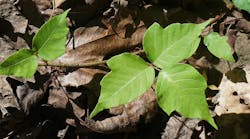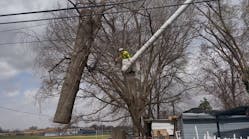It’s common for those in the vegetation management industry to encounter poisonous plants, such as poison ivy, poison oak and poison sumac regularly. Due to this frequent exposure, it is imperative to be able to properly identify the species of poisonous plants and avoid exposure. As the weather begins to warm up across the country and spring makes its entrance, take a moment to brush up on how to identify and avoid these plants.
Taking Preventative Measures
The National Institute for Occupational Safety and Health (NIOSH) defines five levels of safety control measures--from most to least effective—in its Hierarchy of Controls.
- Elimination: Physically remove the hazard
- Substitution: Replace the hazard
- Engineering controls: Isolate people from the hazard
- Administrative controls: Change the way people work
- PPE: Protect the worker with personal protective equipment
While the inverted pyramid lists elimination and substitution as the most effective options, but these are not always applicable controls for poisonous plants in our industry. Administrative controls and PPE are our best measures to prevent a skin injury from contact with these toxic plants.
When it comes to identifying poisonous plants, it’s important to know how to identify leaves, vines, stems, flowers, fruits, and growth habits.
An infographic provided by ACRT offers brief descriptions of poison ivy, poison sumac, and poison oak.
Poison ivy
- Three leaflets connected to a single stem
- Young leaves are light green and have serrated edges
- White berries can be found on the plant
- Grows as a vine or shrub
- Leaves appear as a mixture of red and green with green flower buds in the spring
- During the summer, leaves will turn completely green and nearly hide the small, off-white berries
- Leaves turn bright orange, yellow, and red in the fall
- In the wintertime, leaves will be gone, but red, hairy roots and white berries become more visible
- Found in all parts of the United States except California, Hawaii, and Alaska
Poison sumac
- Nine to 13 leaflets per stem
- Leaves are round with pointed tips
- Grows as a shrub or small tree
- Displays bright orange leaves in the early spring
- Leaves become dark green and glossy during the summer
- In the fall, leaves will turn red-orange
- During the winter, poison sumac will be leafless with thin, empty stems hanging from branches that look similar to grape stems
- Found in swampy areas of the Southeast
Poison oak
- Three leaflets connected to a single stem
- Leaves resemble oak tree leaves
- Grows as a vine or shrub
- During the spring, leaves will appear shiny, smooth and very green
- In the summer, leaves are still pretty green, but also display greenish blooms
- The famous reddish leaves appear during the fall
- In winter months, poison oak will lose its leaves and have fuzzy, reddish-brown sticks with alternating stubs
- Found on the West Coast and in Southeastern states
Urushiol, the oil released in sap from poison ivy, poison oak and poison sumac, can remain on clothing, skin, gloves, and tools for extended periods — even years, if not cleaned properly. Urushiol is what causes contact dermatitis — meaning you do not have to touch the plant itself to suffer a reaction.
Johns Hopkins Medicine notes, the allergic reaction to these plants is usually in the form of contact dermatitis, which typically happens 24 to 72 hours after exposure. Since there isn’t a cure for this type of reaction once rashes and blisters begin to develop, the best treatment is to avoid poisonous plants by learning what they look like and restraining from touching them.
In most cases, a rash or blister will only develop where urushiol has come in contact with a person. The rash will not spread by itself, but a person may develop additional rashes or blisters if they handle contaminated items. Do not rub or scratch rashes or blisters, as infection could result from dirty fingernails.
What to do if exposed to a poisonous plant
NIOSH recommends the following first aid actions when someone comes in contact with poisonous plants.
- Immediately rinse skin with rubbing alcohol, specialized poison plant washes, degreasing soap (such as dishwashing soap) or detergent, and lots of water.
- Scrub under nails with a brush.
- Apply wet compresses, calamine lotion, or hydrocortisone cream to the skin to reduce itching and blistering.
- An antihistamine such as diphenhydramine (Benadryl) can be taken to help relieve itching.
- In severe cases or if the rash is on the face, seek professional medical attention.
- ·Call 911 or go to a hospital emergency room if the worker is suffering a severe allergic reaction, such as swelling or difficulty breathing, or has had a severe reaction in the past.
How to protect yourself from poisonous plants
Those working outdoors are at a heightened risk of exposure to poisonous plants. NIOSH offers advice on how to better protect yourself.
- Wear long sleeves, long pants, boots, and gloves.
- Barrier skin creams, such as lotion containing bentoquatam, may offer some protection.
- After use, clean tools with rubbing alcohol or soap, and lots of water.
- Do not burn plants or brush piles that may contain poison ivy, poison oak, or poison sumac.
Several of these plants are toxic throughout the year, and some have chemicals that are activated when exposed to sunlight. Whether you’re outdoors for work or play, remember, identification and avoidance are key, then PPE.


